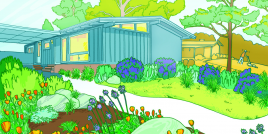Turning your perfectly unnatural (yet impressively green!) lawn into an imperfectly wild(ish) piece of land requires a little time and energy at first. And then...a lot less mowing. -- Most American yards don’t reflect their ecological condition. The plants need to be treated with fertilizer because the soil’s not right. They want water the weather doesn’t provide. Wildlife disappears because they no longer have food to eat. All this creates more labor for homeowners, the humans in this ecosystem, because they’re working against nature instead of with it. “A garden that’s planted purely by aesthetic decisions is like a car with no engine,” says Larry Weaner, founder and principal of Larry Weaner Landscape Associates in Glenside, Pennsylvania. “It may look beautiful, the stereo works great, but you’re going to have to push it up the hill.” A yard should have an engine. You just have to grow plants adapted to your landscape and work with wildlife instead of trying to control it, which will foster diversity and stability in your local ecosystem. More than ornaments, plants have functions in a regenerative system. When you engage the natural landscape, you reconnect to your region and your ecosystem, and create a piece of land that reflects its place. Here’s how.










